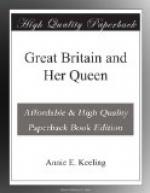The disaffection so fruitful of suffering had been due to a suspicion that men were retained in departmental offices when they no longer had the confidence of the people. Now such officials are only elected for six years, though eligible for re-election. One-sixth of the laymen on Connexional committees retire yearly; they may be re-elected, but must receive a four-fifths vote. Visitors may be present when the President is inducted into office, and during the representative session, when also reporters other than ministers are now allowed to take notes.
It was the year 1878 which witnessed that most important development of Methodist economy, the introduction of lay representatives to take part with ministers in the deliberations of Conference. This was no sudden revolution; laymen had long had their share in the work of quarterly meetings, district synods, and great Connexional committees; in 1861 they were admitted to the Committees of Review, which arranged the business of Conference; they sat in the nomination committee each year, and had power to scrutinise, and even to alter, the lists of names for the various committees. Now in natural sequence they were to be endowed with legislative as well as consultative functions; it might be said they had been educated to this end.
The committee appointed to consider the matter having done its work, the report was submitted to the district synods and then to Conference. Long, earnest, animated, but loving was the debate that ensued; the assembled ministers, by a large majority, determined that the laity should henceforth share in their deliberations on all questions not strictly pastoral.
It was resolved that there should be a representative session of 240 ministers and 240 laymen. The ministerial quota was to consist of President and secretary, members of the Legal Hundred, assistant secretary, chairmen of districts not members of the Hundred, and representatives of the great departments; six ministers stationed in foreign countries, but visiting England at the time; and the remainder elected by their brethren in the district synods; the laymen to be elected in the synods by laymen only. A small proportion at one Conference is chosen to attend the next.
Such were the new arrangements that came into force in 1878, causing no friction, since they secured “a maximum of adaptation with a minimum of change”; there was no difficulty in deciding what business should belong to either session of Conference. It is needless to dwell here on minor alterations, introduced in the past, or contemplated for the future, as to the order of the sessions; it may amply suffice us to remark that Wesleyan Methodism, thanks to the modifications of its constitution which we have briefly touched upon, is one of the most truly popular Church systems ever devised. For, as the Pastoral Address of 1896 puts it, “Methodism gives every class, every member, all the rights which can be reasonably claimed, listens to every complaint, asserts no exclusive privilege, but insures that all things are done ‘decently and in order.’”




